Intel Core i7-11700K Review: Blasting Off with Rocket Lake
by Dr. Ian Cutress on March 5, 2021 4:30 PM EST- Posted in
- CPUs
- Intel
- 14nm
- Xe-LP
- Rocket Lake
- Cypress Cove
- i7-11700K
CPU Tests: Encoding
One of the interesting elements on modern processors is encoding performance. This covers two main areas: encryption/decryption for secure data transfer, and video transcoding from one video format to another.
In the encrypt/decrypt scenario, how data is transferred and by what mechanism is pertinent to on-the-fly encryption of sensitive data - a process by which more modern devices are leaning to for software security.
Video transcoding as a tool to adjust the quality, file size and resolution of a video file has boomed in recent years, such as providing the optimum video for devices before consumption, or for game streamers who are wanting to upload the output from their video camera in real-time. As we move into live 3D video, this task will only get more strenuous, and it turns out that the performance of certain algorithms is a function of the input/output of the content.
HandBrake 1.32: Link
Video transcoding (both encode and decode) is a hot topic in performance metrics as more and more content is being created. First consideration is the standard in which the video is encoded, which can be lossless or lossy, trade performance for file-size, trade quality for file-size, or all of the above can increase encoding rates to help accelerate decoding rates. Alongside Google's favorite codecs, VP9 and AV1, there are others that are prominent: H264, the older codec, is practically everywhere and is designed to be optimized for 1080p video, and HEVC (or H.265) that is aimed to provide the same quality as H264 but at a lower file-size (or better quality for the same size). HEVC is important as 4K is streamed over the air, meaning less bits need to be transferred for the same quality content. There are other codecs coming to market designed for specific use cases all the time.
Handbrake is a favored tool for transcoding, with the later versions using copious amounts of newer APIs to take advantage of co-processors, like GPUs. It is available on Windows via an interface or can be accessed through the command-line, with the latter making our testing easier, with a redirection operator for the console output.
We take the compiled version of this 16-minute YouTube video about Russian CPUs at 1080p30 h264 and convert into three different files: (1) 480p30 ‘Discord’, (2) 720p30 ‘YouTube’, and (3) 4K60 HEVC.
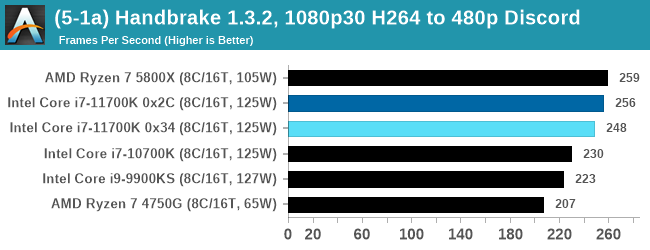
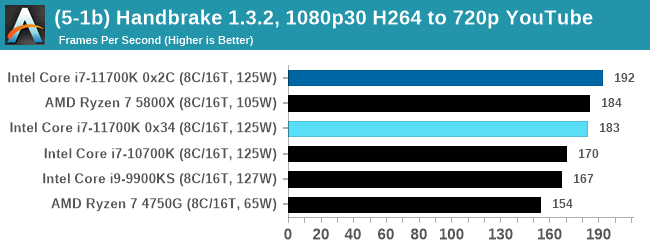
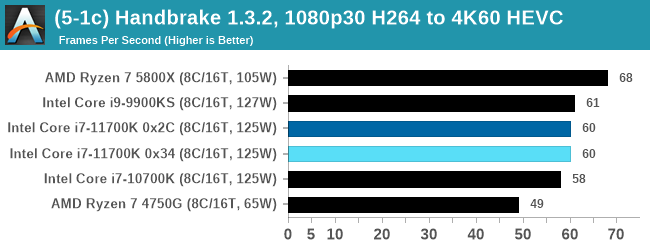
Up to the final 4K60 HEVC, in CPU-only mode, the Intel CPU puts up some good gen-on-gen numbers.
7-Zip 1900: Link
The first compression benchmark tool we use is the open-source 7-zip, which typically offers good scaling across multiple cores. 7-zip is the compression tool most cited by readers as one they would rather see benchmarks on, and the program includes a built-in benchmark tool for both compression and decompression.
The tool can either be run from inside the software or through the command line. We take the latter route as it is easier to automate, obtain results, and put through our process. The command line flags available offer an option for repeated runs, and the output provides the average automatically through the console. We direct this output into a text file and regex the required values for compression, decompression, and a combined score.
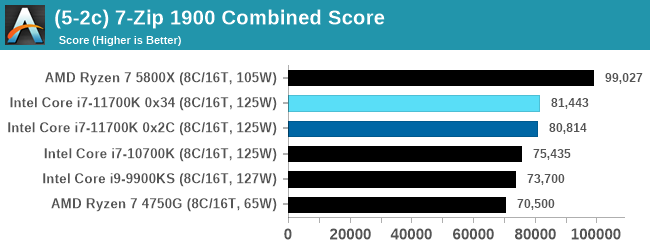
An increase over the previous generation, but AMD has a 25% lead.
AES Encoding
Algorithms using AES coding have spread far and wide as a ubiquitous tool for encryption. Again, this is another CPU limited test, and modern CPUs have special AES pathways to accelerate their performance. We often see scaling in both frequency and cores with this benchmark. We use the latest version of TrueCrypt and run its benchmark mode over 1GB of in-DRAM data. Results shown are the GB/s average of encryption and decryption.
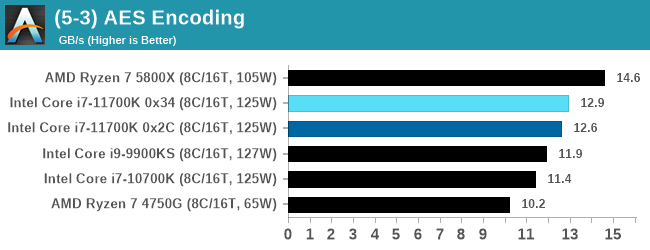
WinRAR 5.90: Link
For the 2020 test suite, we move to the latest version of WinRAR in our compression test. WinRAR in some quarters is more user friendly that 7-Zip, hence its inclusion. Rather than use a benchmark mode as we did with 7-Zip, here we take a set of files representative of a generic stack
- 33 video files , each 30 seconds, in 1.37 GB,
- 2834 smaller website files in 370 folders in 150 MB,
- 100 Beat Saber music tracks and input files, for 451 MB
This is a mixture of compressible and incompressible formats. The results shown are the time taken to encode the file. Due to DRAM caching, we run the test for 20 minutes times and take the average of the last five runs when the benchmark is in a steady state.
For automation, we use AHK’s internal timing tools from initiating the workload until the window closes signifying the end. This means the results are contained within AHK, with an average of the last 5 results being easy enough to calculate.
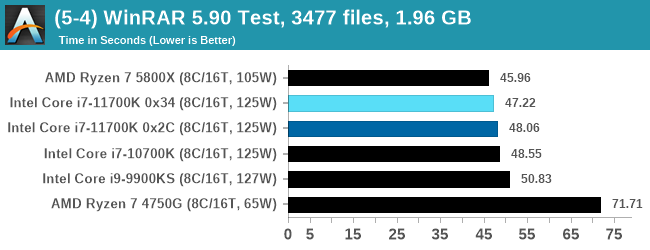
CPU Tests: Legacy and Web
In order to gather data to compare with older benchmarks, we are still keeping a number of tests under our ‘legacy’ section. This includes all the former major versions of CineBench (R15, R11.5, R10) as well as x264 HD 3.0 and the first very naïve version of 3DPM v2.1. We won’t be transferring the data over from the old testing into Bench, otherwise it would be populated with 200 CPUs with only one data point, so it will fill up as we test more CPUs like the others.
The other section here is our web tests.
Web Tests: Kraken, Octane, and Speedometer
Benchmarking using web tools is always a bit difficult. Browsers change almost daily, and the way the web is used changes even quicker. While there is some scope for advanced computational based benchmarks, most users care about responsiveness, which requires a strong back-end to work quickly to provide on the front-end. The benchmarks we chose for our web tests are essentially industry standards – at least once upon a time.
It should be noted that for each test, the browser is closed and re-opened a new with a fresh cache. We use a fixed Chromium version for our tests with the update capabilities removed to ensure consistency.
Mozilla Kraken 1.1
Kraken is a 2010 benchmark from Mozilla and does a series of JavaScript tests. These tests are a little more involved than previous tests, looking at artificial intelligence, audio manipulation, image manipulation, json parsing, and cryptographic functions. The benchmark starts with an initial download of data for the audio and imaging, and then runs through 10 times giving a timed result.
We loop through the 10-run test four times (so that’s a total of 40 runs), and average the four end-results. The result is given as time to complete the test, and we’re reaching a slow asymptotic limit with regards the highest IPC processors.
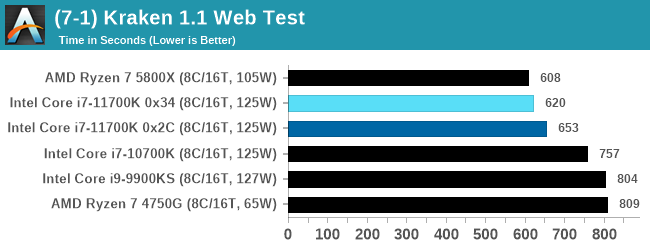
Google Octane 2.0
Our second test is also JavaScript based, but uses a lot more variation of newer JS techniques, such as object-oriented programming, kernel simulation, object creation/destruction, garbage collection, array manipulations, compiler latency and code execution.
Octane was developed after the discontinuation of other tests, with the goal of being more web-like than previous tests. It has been a popular benchmark, making it an obvious target for optimizations in the JavaScript engines. Ultimately it was retired in early 2017 due to this, although it is still widely used as a tool to determine general CPU performance in a number of web tasks.
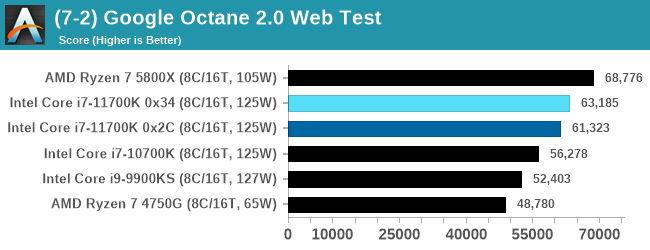
Speedometer 2: JavaScript Frameworks
Our newest web test is Speedometer 2, which is a test over a series of JavaScript frameworks to do three simple things: built a list, enable each item in the list, and remove the list. All the frameworks implement the same visual cues, but obviously apply them from different coding angles.
Our test goes through the list of frameworks, and produces a final score indicative of ‘rpm’, one of the benchmarks internal metrics.
We repeat over the benchmark for a dozen loops, taking the average of the last five.
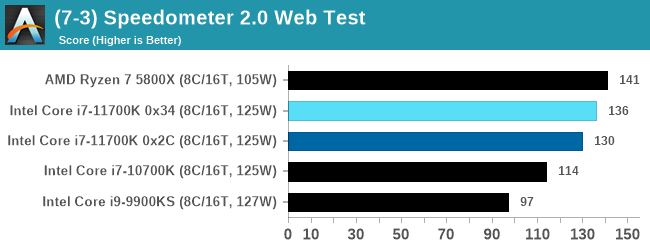
Legacy Tests
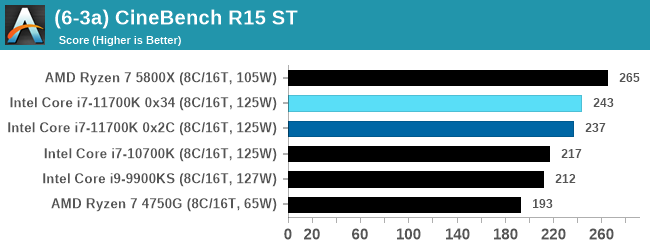
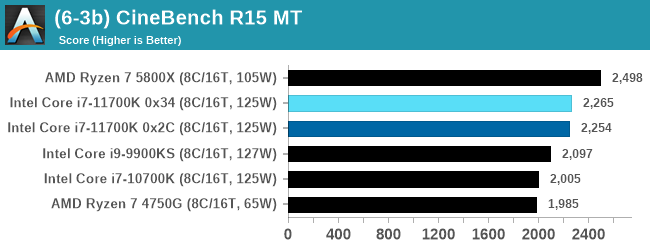
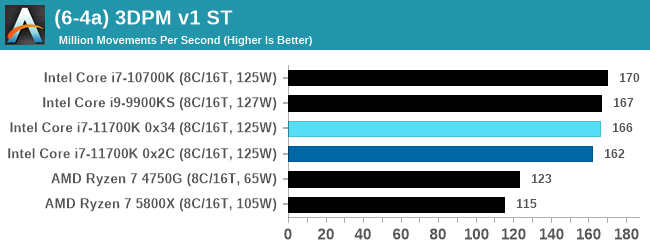
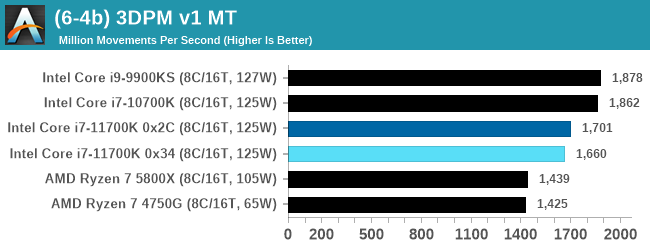


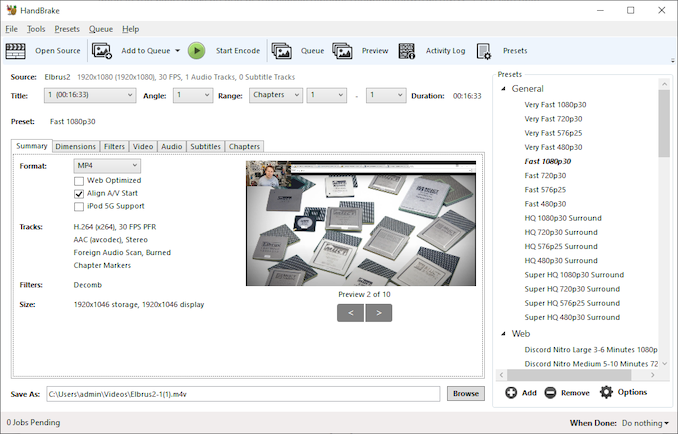
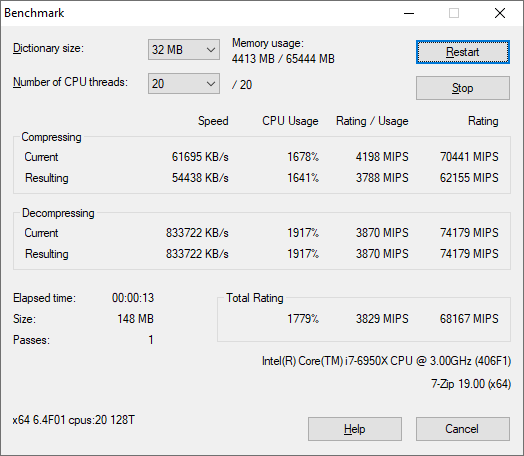
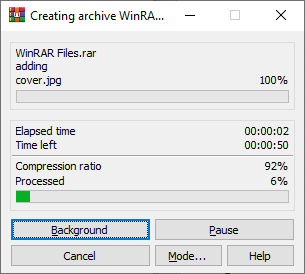

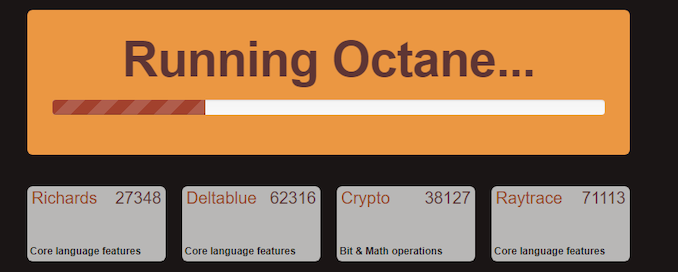
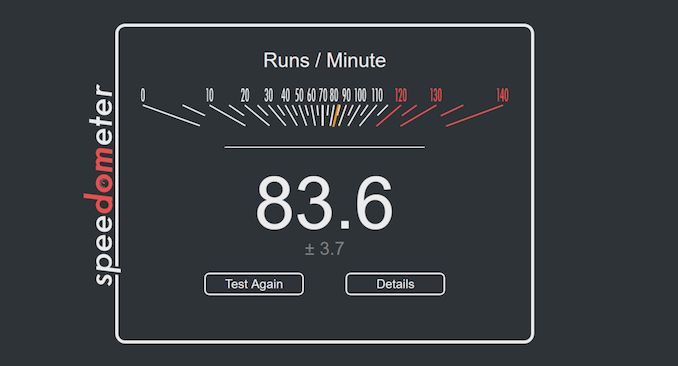








541 Comments
View All Comments
TheinsanegamerN - Friday, March 5, 2021 - link
That 14nm chip pulls over twice the power of the 7nm 16 core chip and is consistently slower then 7nm 8 core chip.It's not so much "right behind them" but rather "barely keeping up while burning through a nuclear reactor's power output".
CiccioB - Friday, March 5, 2021 - link
Twice the power for being slower?If you are referring to the 290W power consumption with AVX-512 test, I'm desolate to inform you that a 7nm CPU with twice the core would not reach those performances and perf/W in that test.
If you are talking about the 140-160W usage at other "normal" tests, I'm desolate to inform you that a 16 core 7nm CPU does not consumes 80W.
So stop vomiting meaningless numbers. This is a 14nm CPU and for the process it is build on it is doing miracles. If Intel could ever use an advanced PP like those 7nm by TSMC Zen would still be the underdog.
For the future just hope the TMSC 5nm are good, early, low cost and really high yielding, because if Intel comes with a decent 7nm I think AMD will not look all that advanced (6 years to surpass a 6 years old architecture and all by the use of a more advanced PP that unfortunately doesn't allow for great deliveries).
blppt - Friday, March 5, 2021 - link
"So stop vomiting meaningless numbers. This is a 14nm CPU and for the process it is build on it is doing miracles. If Intel could ever use an advanced PP like those 7nm by TSMC Zen would still be the underdog."Not necessarily. Intel apparently is still behind in IPC/single thread performance, as evidenced by that Cinebench results, so whilst 7nm would let it run with less power (theoretically), it still would lose to its main competitor, the 5800X.
CiccioB - Friday, March 5, 2021 - link
You have missed that with 14nm die area you cannot improve the architecture that much.You are still thinking that CPU designed for 7nm, with all the advantages that they would bring, would still be like Skylake which is a 6 years old architecture
A PP like TSMC 7nm would bring a completely new architecture that would blow Zen away.
Zen is good because it is based on such a better PP that those Intel has now, but it still struggles at beating Skylake. And to do that it, that is by using such an advanced but production limited PP, it has sacrificed high stock delivery right in the period where demand is much higher than supply.
Intel can fill the remaining market with whatever it has, being it 9xxx, 10xx or now 11xx generations.
barich - Friday, March 5, 2021 - link
Yes, Intel probably would beat AMD with an imaginary all-new architecture on TSMC's 7nm process. Similarly, I would be a hell of a basketball player if I were a foot taller and had any motor skills.Here in reality, Intel has worse performance and worse efficiency. As a consumer, that's what matters to me. What Intel could do with a bunch of "ifs" is irrelevant. I haven't owned an AMD CPU since my Athlon 64 was replaced by a Core 2 Duo. But there's no way my new build this year isn't going to be AMD.
CiccioB - Saturday, March 6, 2021 - link
Yes, what counts is the results, you are right.But by that I can't cry for a miracle when I see Zen 3 results as with a much more advanced PP it just can win over Skylake for a few % and all the real advantages it has is smaller power consumption due to the much better PP vs this one 6 years old.
If you look at the real power consumption, that is not the one with AVX-512 tests where RKL disintegrates Zen for perf/W despite the high power requirements, you'll see that this chip is not that power hungry (though being more power hungry than Zen) and that does make me think that with a better PP this same architecture would be another thing completely, as are the 10nm Tiger Lake which however suffer the not so good power consumption at higher frequency required by desktop SKUs.
As we are not that distant from finally having something decent that is not the 14nm PP, I will really not call my thought "imaginary". AMD will not be able to pass to 5nm so soon, and seen what this architecture can do, despote the 14nm PP, I think that the future is going to be more interesting that what you hope it ti be (that is, AMD keeps on figure it has better CPUs while not having them in the shelves but what counts for you are.. yes the results... and for these Intel is outselling AMD 5:1).
blppt - Saturday, March 6, 2021 - link
"A PP like TSMC 7nm would bring a completely new architecture that would blow Zen away."Based on what, exactly? We've seen die shrinks before without amazing architectural advances from both Intel and AMD. You have an awful lot of confidence in something that doesn't exist.
CiccioB - Saturday, March 6, 2021 - link
Based on the fact that with a 7nm PP AMD still struggles at beating Skylake architecture which is 6 years old and was born on... oh yes, 14nm.schujj07 - Saturday, March 6, 2021 - link
Zen2 was already faster than Skylake and its derivatives clock for clock by about 7%. While Comet Lake had higher single threaded performance than Zen2, it did so by throwing efficiency and power draw out the window and going for absolute performance. That made it such that Comet Lake could compete in ST applications but it still lost on MT applications against the same thread counted AMD CPUs. Going for absolute performance has been a double edged sword for Intel as the newer architectures hadn't been able to clock as high. Despite the higher IPCs of the newer architectures, absolute performance was no better than a wash due to 20% lower clock speeds.Zen3 now has absolute performance dominance over any Skylake architecture CPU. It doesn't "just" beat the older CPU, as in like 2% faster. It is upwards of 20% faster clock for clock and 10%+ faster in absolute ST performance.
blppt - Saturday, March 6, 2021 - link
"Based on the fact that with a 7nm PP AMD still struggles at beating Skylake architecture which is 6 years old and was born on... oh yes, 14nm."Struggles? The slightly older AMD chip (5800X) beats the newest and greatest out of Intel, whilst consuming less power, AND hitting lower peak turbo speeds.
That is complete domination. You could make the same argument about how Intel hadn't even made any significant gains over Sandy Bridge until Skylake, and that was *2* die shrinks.